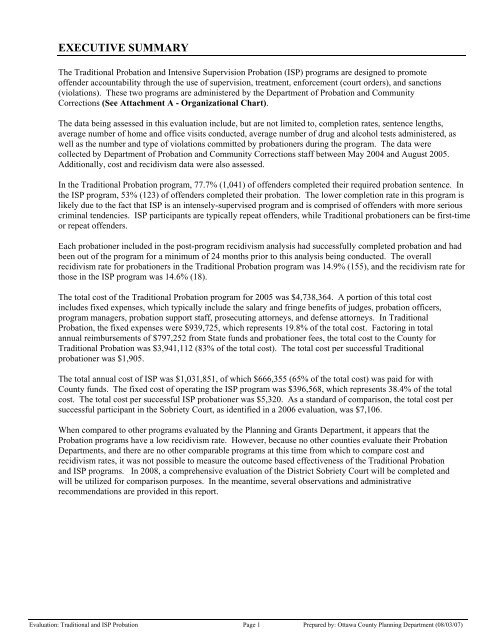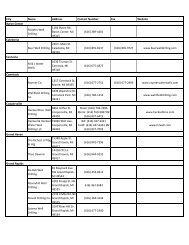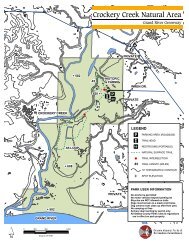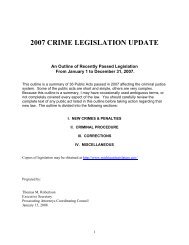Traditional Probation & Intensive Supervision ... - Ottawa County
Traditional Probation & Intensive Supervision ... - Ottawa County
Traditional Probation & Intensive Supervision ... - Ottawa County
Create successful ePaper yourself
Turn your PDF publications into a flip-book with our unique Google optimized e-Paper software.
EXECUTIVE SUMMARYThe <strong>Traditional</strong> <strong>Probation</strong> and <strong>Intensive</strong> <strong>Supervision</strong> <strong>Probation</strong> (ISP) programs are designed to promoteoffender accountability through the use of supervision, treatment, enforcement (court orders), and sanctions(violations). These two programs are administered by the Department of <strong>Probation</strong> and CommunityCorrections (See Attachment A - Organizational Chart).The data being assessed in this evaluation include, but are not limited to, completion rates, sentence lengths,average number of home and office visits conducted, average number of drug and alcohol tests administered, aswell as the number and type of violations committed by probationers during the program. The data werecollected by Department of <strong>Probation</strong> and Community Corrections staff between May 2004 and August 2005.Additionally, cost and recidivism data were also assessed.In the <strong>Traditional</strong> <strong>Probation</strong> program, 77.7% (1,041) of offenders completed their required probation sentence. Inthe ISP program, 53% (123) of offenders completed their probation. The lower completion rate in this program islikely due to the fact that ISP is an intensely-supervised program and is comprised of offenders with more seriouscriminal tendencies. ISP participants are typically repeat offenders, while <strong>Traditional</strong> probationers can be first-timeor repeat offenders.Each probationer included in the post-program recidivism analysis had successfully completed probation and hadbeen out of the program for a minimum of 24 months prior to this analysis being conducted. The overallrecidivism rate for probationers in the <strong>Traditional</strong> <strong>Probation</strong> program was 14.9% (155), and the recidivism rate forthose in the ISP program was 14.6% (18).The total cost of the <strong>Traditional</strong> <strong>Probation</strong> program for 2005 was $4,738,364. A portion of this total costincludes fixed expenses, which typically include the salary and fringe benefits of judges, probation officers,program managers, probation support staff, prosecuting attorneys, and defense attorneys. In <strong>Traditional</strong><strong>Probation</strong>, the fixed expenses were $939,725, which represents 19.8% of the total cost. Factoring in totalannual reimbursements of $797,252 from State funds and probationer fees, the total cost to the <strong>County</strong> for<strong>Traditional</strong> <strong>Probation</strong> was $3,941,112 (83% of the total cost). The total cost per successful <strong>Traditional</strong>probationer was $1,905.The total annual cost of ISP was $1,031,851, of which $666,355 (65% of the total cost) was paid for with<strong>County</strong> funds. The fixed cost of operating the ISP program was $396,568, which represents 38.4% of the totalcost. The total cost per successful ISP probationer was $5,320. As a standard of comparison, the total cost persuccessful participant in the Sobriety Court, as identified in a 2006 evaluation, was $7,106.When compared to other programs evaluated by the Planning and Grants Department, it appears that the<strong>Probation</strong> programs have a low recidivism rate. However, because no other counties evaluate their <strong>Probation</strong>Departments, and there are no other comparable programs at this time from which to compare cost andrecidivism rates, it was not possible to measure the outcome based effectiveness of the <strong>Traditional</strong> <strong>Probation</strong>and ISP programs. In 2008, a comprehensive evaluation of the District Sobriety Court will be completed andwill be utilized for comparison purposes. In the meantime, several observations and administrativerecommendations are provided in this report.Evaluation: <strong>Traditional</strong> and ISP <strong>Probation</strong> Page 1 Prepared by: <strong>Ottawa</strong> <strong>County</strong> Planning Department (08/03/07)
















